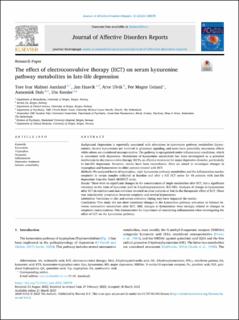The effect of electroconvulsive therapy (ECT) on serum kynurenine pathway metabolites in late-life depression
Aarsland, Tore Ivar Malmei; Haavik, Jan; Ulvik, Arve; Ueland, Per Magne; Dols, Annemiek; Kessler, Ute
Journal article, Peer reviewed
Published version

Åpne
Permanent lenke
https://hdl.handle.net/11250/3100841Utgivelsesdato
2023Metadata
Vis full innførselSamlinger
- Department of Clinical Science [2295]
- Registrations from Cristin [9489]
Originalversjon
Journal of Affective Disorders Reports. 2023, 12, 100578. 10.1016/j.jadr.2023.100578Sammendrag
Background
Depression is reportedly associated with alterations in kynurenine pathway metabolites (kynurenines). Several kynurenines are involved in glutamate signaling, and some have potentially neurotoxic effects while others are considered neuroprotective. The pathway is upregulated under inflammatory conditions, which is associated with depression. Modulation of kynurenine metabolism has been investigated as a potential mechanism in electroconvulsive therapy (ECT), an effective treatment for major depressive disorder, particularly in late-life depression. However, results have been inconclusive. Here we aimed to investigate changes in tryptophan and kynurenines in older patients treated with ECT.
Methods
We analyzed levels of tryptophan, eight kynurenine pathway metabolites and the inflammation marker neopterin in serum samples collected at baseline and after a full ECT series for 48 patients with late-life depression from the Dutch MODECT study.
Results
There were no significant changes in the concentration of single metabolites after ECT, but a significant reduction in the ratio of kynurenic acid to 3-hydroxykynurenine (KA/HK). Analyses of change in kynurenines after ECT in remitters and non-remitters revealed no clear patterns or link to the therapeutic effect of ECT. There was considerable covariation between neopterin and several kynurenines.
Limitations
Variations in diet and serum collection timing may have impacted the results.
Conclusions
This study did not show consistent changes in the kynurenine pathway activation or balance between neuroactive metabolites after ECT. Still, changes in kynurenines were strongly related to changes in neopterin concentrations. This demonstrates the importance of considering inflammation when investigating the effect of ECT on the kynurenine pathway.
